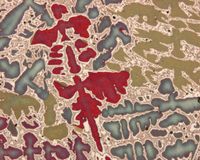
Photo from wikipedia
In many engineering applications of piezoelectric materials, the design and prediction of the dynamic characteristics depends on the anisotropic electromechanical material property. Through collecting the complete formula in literature and… Click to show full abstract
In many engineering applications of piezoelectric materials, the design and prediction of the dynamic characteristics depends on the anisotropic electromechanical material property. Through collecting the complete formula in literature and listing all the prepared specimens, transversely isotropic material constants were obtained and verified by dynamic non-destructive evaluation in the paper. The IEEE (Institute of Electrical and Electronics Engineers) resonance method was applied to measure and calculate the orthotropic material constants for piezoelectric ceramics. Five specimens need to be prepared for the measurements using an impedance analyzer, in order to obtain the resonant and anti-resonant frequencies from the modes of thickness extension, length-extension, thickness-shear extension, length-thickness extension, and radial extension. The frequencies were substituted into the formulas guided on the IEEE standard to determine the elastic, dielectric, and piezoelectric constants. The dynamic characteristics of soft and hard piezoelectric ceramics in the results from the finite element method (FEM), which is analyzed from the anisotropic material constants of the resonance method, were verified with the mode shapes and natural frequencies found by experimental measurements. In self-heating, considered as operating on resonant frequencies of piezoelectric material, the resonant frequency and corresponding mode shape calculated by the material constants from resonance method in FEM are more accurate than the material property provided by the manufacturer and literature. When the wide-bandwidth frequency is needed to design the application of piezoelectric ceramics, this study completely provided the measurement method and dynamic verification for the anisotropic electromechanically material property.
Journal Title: Applied Sciences
Year Published: 2020
Link to full text (if available)
Share on Social Media: Sign Up to like & get
recommendations!